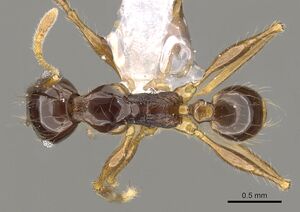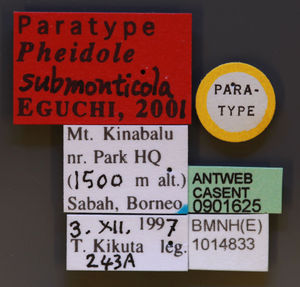Pheidole submonticola
| Pheidole submonticola | |
|---|---|

| |
| Scientific classification | |
| Kingdom: | Animalia |
| Phylum: | Arthropoda |
| Class: | Insecta |
| Order: | Hymenoptera |
| Family: | Formicidae |
| Subfamily: | Myrmicinae |
| Tribe: | Attini |
| Genus: | Pheidole |
| Species: | P. submonticola |
| Binomial name | |
| Pheidole submonticola Eguchi, 2001 | |
This species seems to inhabit well-developed premontane/lower montane forests.
Identification
Eguchi (2001) - This relatively large-sized species with a general habitus is similar to Pheidole aglae and Pheidole cariniceps, but it is peculiar in having a combination of the following conditions: hypostoma of the major completely lacking median processes; propodeal spine of the major elongate-triangular and broadly based; posterior declivity of promesonotal dome of the minor without any prominence; lower part of mesopleuron margined dorsally in the major.
Keys including this Species
- Key to Pheidole majors and minors of Borneo
- Key to Pheidole majors of Borneo
- Key to Pheidole minors of Borneo
Distribution
Distribution based on Regional Taxon Lists
Indo-Australian Region: Borneo (type locality), Indonesia, Malaysia.
Distribution based on AntMaps
Distribution based on AntWeb specimens
Check data from AntWeb
Countries Occupied
| Number of countries occupied by this species based on AntWiki Regional Taxon Lists. In general, fewer countries occupied indicates a narrower range, while more countries indicates a more widespread species. |

|
Estimated Abundance
| Relative abundance based on number of AntMaps records per species (this species within the purple bar). Fewer records (to the left) indicates a less abundant/encountered species while more records (to the right) indicates more abundant/encountered species. |

|
Biology
Castes
Worker
Minor
Images from AntWeb
   
| |
| Paratype of Pheidole submonticola. Worker. Specimen code casent0901625. Photographer Ryan Perry, uploaded by California Academy of Sciences. | Owned by NHMUK, London, UK. |
Nomenclature
The following information is derived from Barry Bolton's Online Catalogue of the Ants of the World.
- submonticola. Pheidole submonticola Eguchi, 2001b: 117, fig. 49 (s.w.) BORNEO.
Unless otherwise noted the text for the remainder of this section is reported from the publication that includes the original description.
Description
Worker
Major (n=1): TL 4.4 mm, HL 2.00 mm, HW 1.90 mm, SL 1.00 mm, FL 1.46 mm, CI 95, SI 53, FI 77. Head broadest at 3/5 distance of head (as measured from the mid-point of a transverse line spanning the anteriormost and posterior most projecting points, respectively); posterior margin of head in full-face view strongly emarginate (Fig. 49A); head in profile gently impressed on vertex (Fig. 49B). Hypostoma without any median process. Clypeus with a median longitudinal carina, with anterior margin emarginate medially. Eye situated in front of 1/3 distance of head; distance between mandibular insertion and anterior margin of eye ca. 1.7 times as long as maximal diameter of eye. Frontal carina weak, extending backward to almost 3/5 distance of head. Antennal scrobe present only around antennal insertion. Antenna with 3-segmented club; scape extending backward to about 3/5 distance of head; terminal segment 0.9 times as long as preceding two segments together. Mandible with apical and preapical teeth, and a denticle in front of basal angle. Promesonotal dome with a very small prominence on its posterior declivity (Fig. 49C); the prominence in anterior view not concave medially; pro meso notal suture (sensu Bolton, 1994) present dorsolaterally as a shallow impression. Mesopleuron divided by a transverse impression into two parts, of which lower part is margined dorsally. Propodeal spine horn-like, broadly based (Fig. 49C), ca. 3.5 times as long as diameter of propodeal spiracle. Petiole cuneiform, ca. 1.2 times as long as postpetiole (excluding helcium); petiolar node apically acute in profile, and weakly emarginate at apex in posterior view. Postpetiole in dorsal view angulate laterally, 2.5 times as broad as petiolar node.
Frons longitudinally rugose, with smooth and shining interspaces; the longitudinal rugulae curving outward on occipital lobe, and interspaces smooth and shining; lateral face of head below subocular level largely rugose longitudinally, but smooth and shining medially; anterior and lateral face of promesonotal dome and lower part of mesopleuron smooth and shining; remainder of alitrunk irregularly and coarsely rugose, with enclosures smooth and shining; lateral faces of petiole and postpetiole very weakly punctured; dorsum of petiole smooth and shining; dorsum of postpetiole almost smooth and shining with several transverse rugulae; anterior part of first gastral tergite around its articulation with postpetiole finely rugose longitudinally. Outer face of mandible sparsely covered with very short appressed hairs, which are 0.03-0.06 mm in length and much shorter than distance between piligerous punctures; submarginal zone of masticatory margin of mandible with a row of longer decumbent hairs. Body reddish-brown; antennae and legs lighter than alitrunk.
Minor (n=8): TL 2.3-2.7 mm, HL 0.69-0.80 mm, HW 0.57-0.65 mm, SL 0.92-1.01 mm, AL 1.04-1.18 mm, FL 1.04-1.16 mm, CI 82-87, SI 155-161, FI 178-182. Head in full-face view oval (Fig. 49D); occipital carina well developed Clypeus with an inconspicuous median longitudinal carina only apically, with anterior margin in full-face view truncate medially. Eye situated just in front of midlength of head; distance between mandibular insertion and anterior margin of eye ca. 0.9 times as long as maximal diameter of eye. Frontal carina and antennal scrobe present only around antennal insertion. Antenna with 3-segmented club; scape extending beyond posterior border of head by more than its 1/3 length; terminal segment 0.8-0.9 times as long as preceding two segments together. Promesonotal dome with a pair of indistinct tubercles, without a prominence on its posterior declivity (Fig. 49E). Mesopleuron without a transverse impression. Propodeal spine elongate-triangular, ca. 1.5 times as long as diameter of propodeal spiracle. Petiole cuneiform, 1.1-1.2 times as long as postpetiole (excluding helcium); petiolar node low, in posterior view not emarginate at apex. Postpetiole in dorsal view subpentagonal, ca. 2.2 times as broad as petiolar node.
Head including clypeus and promesonotum smooth and shining; remainder of alitrunk weakly rugose, with interspaces very weakly punctured but shining; lateral face of petiole very weakly punctured; dorsum of petiole, and postpetiole and gaster smooth and shining. Head, alitrunk and gaster brown to dark brown; mandibles, antennae, legs and waist light brown.
Type Material
Holotype Major, colony: 243A, Mt. Kinabalu (near the Headquarters, ca. 1500 m alt.), Sabah, E. Malaysia (Borneo), T. Kikuta leg., 1997, deposited in Universiti Malaysia Sabah. Paratypes 7 minors from the same colony to which the holotype belongs, deposited in The Natural History Museum, Museum of Comparative Zoology, Naturhistorisches Museum Wien, Vienna, and UMS.
References
- Eguchi, K. 2001a. A revision of the Bornean species of the ant genus Pheidole (Insecta: Hymenoptera: Formicidae: Myrmicinae). Tropics Monograph Series. 2:1-154. (page 117, fig. 49 soldier, worker described)
- Latumahina, F., Borovanska, M., Musyafa, Sumardi, Susetya Putra, N., Janda, M. 2015. Ants of Ambon Island – diversity survey and checklist. ZooKeys 472, 43–57 (doi:10.3897/zookeys.472.8441).
References based on Global Ant Biodiversity Informatics
- Eguchi K. 2001. A revision of the Bornean species of the ant genus Pheidole (Insecta: Hymenoptera: Formicidae: Myrmicinae). Tropics Monograph Series 2: 1-154.
- Helms J. A., S. M. Helms, N. I. Fawzi, Tarjudin, F. Xaverius. 2017. Ant community of an Acacia mangium forest in Indonesian Borneo. Serangga 22(1): 147-159.
- Pfeiffer M.; Mezger, D.; Hosoishi, S.; Bakhtiar, E. Y.; Kohout, R. J. 2011. The Formicidae of Borneo (Insecta: Hymenoptera): a preliminary species list. Asian Myrmecology 4:9-58



